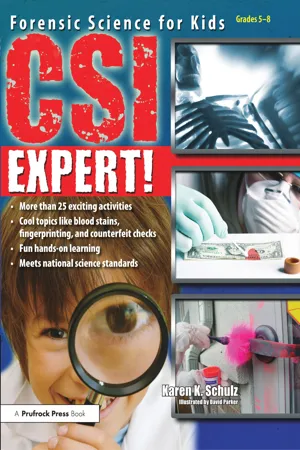
- 156 pages
- English
- ePUB (mobile friendly)
- Available on iOS & Android
About This Book
Crime scene investigation is hotter than ever, and kids everywhere will love learning about how their favorite detectives use science to figure out unsolvable thefts, arsons, mysteries, and more. CSI Expert!: Forensic Science for Kids includes more than 25 in-depth activities on fingerprinting, evidence collection, blood-stain identification, forensic careers, ballistics, and much more.The author of the best-selling Crime Scene Detective series combines more than a decade of experience teaching forensic science to middle school students with the latest technology and research in criminal investigations in the intriguing standards-based scientific study included in CSI Expert! Students will love collecting dental impressions, studying their classmates' fingerprints, looking at tool marks left at the scene of the crime, analyzing mysterious powders, and discovering the various types of counterfeit checks. Each lesson includes a realistic case for students to crack using the knowledge they've learned about analyzing forensic evidence, and the book also includes an assessment assignment that teachers can employ to test their students' learning.Both kids and teachers will be able to easily implement the book's hands-on, detailed, and exciting forensic science experiments using everyday materials. After completing these activities, kids will be begging for more fun science learning!Grades 5-8
Frequently asked questions
Information
The Labs
I Spy: Documenting the Crime Scene
Teacher Instructions
Objective:
Background Information:
Gathering Materials:
Setting Up and Completing the Lab:
- Create or gather the pieces of evidence you will place in your classroom to simulate a crime scene. You may include evidence like fingerprints, shoe prints, a handwritten note, and so on.
- Place the evidence in various places in your classroom. Do this before students arrive to class.
- When class begins, discuss the basic procedures for processing a crime scene as outlined in the background research.
- Distribute the Crime Scene Documentation: Evidence Location Chart found on page 9.
- Ask students to examine the crime scene without touching anything.
- Next, students should sketch the crime scene (classroom) including major points of references such as student desks, computers, door, teacher's desk, tables, etc. They may sketch the room on the back of the Crime Scene Documentation paper.
- As a class, discuss possible pieces of evidence seen in the room. Have students place the lettered cones next to each piece of evidence. For example, the fingerprint might be identified by the cone marked with a letter A, the shoe print by the cone marked with a letter B, and so on.
- Students should then include in their drawings the items that the class has identified as evidence. They should place the letter that identifies the evidence in the appropriate location in the sketch, labeling each piece of evidence by the letter assigned to it.
- Record these letters, a description, and the general location of the evidence in the appropriate places on the Crime Scene Documentation paper.
- To better indicate the location of the evidence, have the students measure the location of each piece of evidence from two fixed points in the room. For example, if a note is located next to the trashcan that is near the door, students may measure the distance the note was from the classroom door and from a sidewall. The trashcan is an object that can be moved so it would not be considered a fixed object and should not be used when taking measurements. These measurements help put into perspective the rough sketch drawn by the student detectives.
- Assign groups of students to measure and record a specific piece of evidence. Time permitting, you may rotate students through each piece of evidence so they can document more than one piece.
- After students have finished processing the scene, discuss why it was necessary to follow certain procedures for searching the crime scene. Another topic for discussion might involve how investigators know if something is valuable evidence or just an item innocently present at the scene.
Special Notes:
Crime Scene Documentation: Evidence Location Chart
| Letter | Description of Evidence and General Location | Description of Fixed Point 1 and Distance from Evidence | Description of Fixed Point 2 and Distance from Evidence |
|---|---|---|---|
| Example: A | Shoeprint on floor by teacher's desk. | Doorframe leftside—56 cm. | Outlet on back wall—34 cm. |
Tool Time: Tool Impression Lab
Teacher Instructions
Objective:
Background Information:
Table of contents
- Cover
- Half Title
- Title Page
- Copyright Page
- Dedication
- Contents
- Teacher's Guide
- The Labs
- Reference Materials
- Answer Key
- About the Author
- Common Core State Standards Alignment